Cities around the world have distinctive modes of transportation — the canals of Venice, the double-decker busses of London, and the Twin Cities (of Minneapolis and St. Paul) have skyways. In both downtowns, there are vast networks of climate-controlled pedestrian bridges that reach over the streets and connect adjacent buildings.
Walk along almost any downtown street in the Twin Cities, and you’ll see a series of these enclosed glass bridges tying together huge office buildings and shopping centers. Thanks to the skyways, people can park in a heated garage, go into work, run some errands, maybe go to the gym, entirely in short sleeves on a sub-zero day. People legitimately brag about how many weeks they can go without stepping foot outside. Minneapolis has the oldest and largest contiguous skyway network in the world and over the years this system has played prominent roles:
Urban geographer and writer Bill Lindeke gives architectural skyway tours in the Twin Cities. He says the visitors on his tours are justifiably impressed. The whole skyway system comes across as a grand civic achievement. They can seem futuristic, triumphant, almost utopian — cozy micro-city within the city, where Twin Citizens can look down at the icy street beneath you, smug in your short sleeves, and collectively laugh in the face of winter. Yet Lindeke actually hates skyways and he isn’t alone — a lot of residents and urban planners want them gone. For critics, skyways are problematic because of who gets to enjoy them and who does not as well as their impact on street activity below.
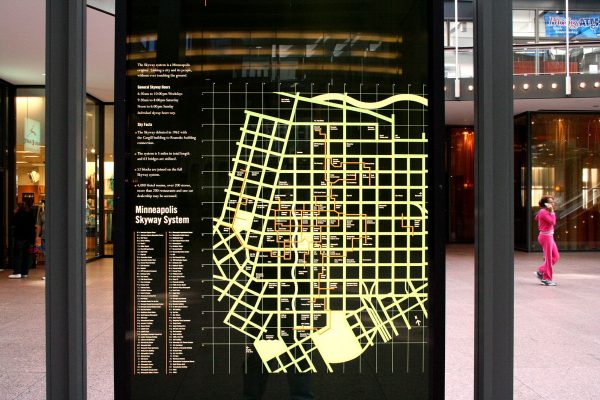
The skyways haven’t always attracted this kind of criticism. In the beginning, long before people like Bill Lindeke turned against them, they were heralded as the salvation of a struggling downtown. In the 1950s, like many cities across the country, Minneapolis was trying to stay lively, or even occupied, in the postwar era of white flight. Downtown shops suffered as people moved out to the suburbs, where, among other things, something new had come along: shopping malls.
Over the decades, more and more shoppers and businesses would decamp from the city to the suburban oasis. But in the late 1950s, a loose alliance of Minneapolis developers, business owners and city officials began formulating plans to lure people back to downtown. Ambitious ideas were proposed, like the installation of pedestrian underpasses or the opposite: sinking street traffic below the surface while turning aboveground roads into pedestrian plazas.
In the end, the winning idea came from a local business owner named Leslie Park who saw a way to make downtown more like a shopping mall. He got the city to grant him air rights, not just for the new building he was constructing, but for the street in front of it. And once it was finished, like a lot of other places downtown, this new building had the usual set of stores on the first floor, but above: the city’s first skyway, connecting two buildings that each featured second-story retail as well. And that transformation of the second floor into a space for pedestrians and workers would go on to reshape the Twin Cities. Developers began to see the appeal of two levels of retail while shoppers and employees enjoyed the ability to travel above traffic. Other building owners began to cut deals to join their structures, too.
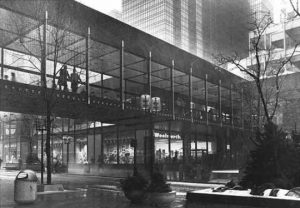
In Minneapolis, skyways became a standard feature in new construction. Impressed by the new indoor development in their sister city across the Mississippi River, St. Paul officials started developing their own city-run skyway system. Everyone wanted to be on the second floor. Even classic downtown mom-and-pop shops and shoe shines moved to the skyways, and customers followed. Within a few years, the average downtown worker in Minneapolis and St. Paul was spending twice as much money as their counterpart in other cities during their lunch break. In the skyways, it was just so easy to buy things, uninterrupted: you could walk to the food court for lunch, get your shoes shined along the way, pick up a gift or a new watch all without stopping for traffic or even putting on your coat.
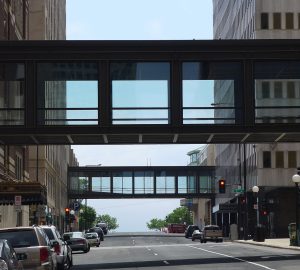 James Garrett, Jr. is an architect in downtown Saint Paul. He lives and works in buildings connected by the skyways. And as a kid in the 1980s, the skyways were his happy place. Kids who grew up in the early days of the skyway network played in the halls and enjoyed exploring the city. Over the decades, though, he noticed a shift — there were a lot more white-collar workers than there were kids from nearby neighborhoods. There was also an increased police and security presence. to the point where the skyways stopped being fun, or even comfortable, especially for young Black men like Garrett. And in a way, this is precisely what they were designed to do — not to be accessible spaces, but rather to replicate the suburban white experience in the Twin Cities’ downtowns.
James Garrett, Jr. is an architect in downtown Saint Paul. He lives and works in buildings connected by the skyways. And as a kid in the 1980s, the skyways were his happy place. Kids who grew up in the early days of the skyway network played in the halls and enjoyed exploring the city. Over the decades, though, he noticed a shift — there were a lot more white-collar workers than there were kids from nearby neighborhoods. There was also an increased police and security presence. to the point where the skyways stopped being fun, or even comfortable, especially for young Black men like Garrett. And in a way, this is precisely what they were designed to do — not to be accessible spaces, but rather to replicate the suburban white experience in the Twin Cities’ downtowns.
The cities were changing outside, too. Once it was assumed that new buildings would be connected on the second floor, architects and planners began a long trend of designing away from parks and outdoor areas, and toward indoor spaces. They turned their back on the street.

Meanwhile, since the Minneapolis skyways were privately owned, the developers had no obligation to be welcoming. The entrances to the system were often obfuscated in high-end hotels or expensive stores. Every now and then, architectural consultants hired by one of the cities would suggest ways to improve skyway access. But some property owners have argued easier entrances would bring the “wrong element” into the skyways. Others complained about the potential costs.
In Minneapolis, the skyways have always been privately owned, based on agreements between connected buildings’ landlords. Thus, lingering too long in the passageway can get you cited for trespassing on private property. And while St. Paul’s system is technically public, they still mostly connect privately owned office buildings and shopping centers, and are monitored by both private security and police. So in practice, the two cities’ systems have both grown to feel like restricted spaces that aren’t particularly welcoming to anyone besides the mostly white and mostly white-collar commuters who work downtown.
Meanwhile, as the skyways grew less appealing to anyone who didn’t work there, anyone who didn’t work there simply stopped going. By the early ’90s, far fewer people were using the skyways to do weekend shopping or enjoy nighttime entertainment, just as building owners became less inclined to attract non-work-day crowds. And on the streets below, where life was drained to populate the skyways and the cities were redesigned around them, the streets grew emptier. Then to top it all off: the Mall of America opened — a megamall to end all malls, complete with a gigantic indoor amusement park.
The answer, some argue, is to tear down the skyways. There are plenty of bustling neighborhoods in the Twin Cities known for their culture, attractions, and street life, even in the winter, proving that Minnesotans will spend time outside in cold weather if given the chance. The other option is to make the skyways work — rethink their accessibility and use their strengths to reshape the Twin Cities for the better.
For even more stories and photos of specific skyways, be sure to check out reporter Katie Thornton’s original longform essay about the history of the skyways, on Instagram at “itskatiethornton,” or on her website.
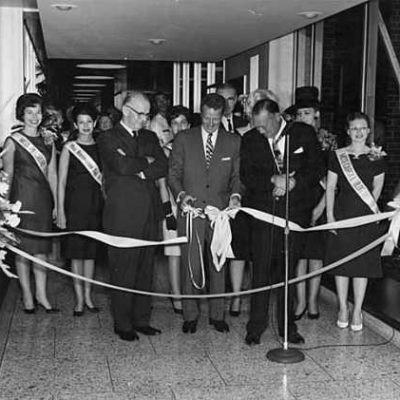
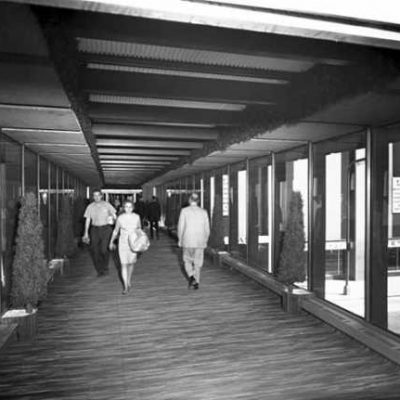



Comments (24)
Share
Calgary Alberta Canada has its own version of the skyway. They were the set for a classic Canadian comedy WAYDOWNTOWN. Check out https://m.imdb.com/title/tt0219405/
Its a wonderful little film.
I too was going to point to Waydowntown. I loved that movie, it reminded me of living in Edmonton which has its own downtown network and Montreal where it is mostly underground.
Liverpool attempted something similar but it didn’t really get anywhere. There’s a short ignite video here https://m.youtube.com/watch?v=f9CyqM1e1GM
The Skyways are great, but there are a number of improvements that need to be made:
1. There needs to be a skyway connecting downtown Minneapolis and downtown Saint Paul.
2. There needs to be a lazy river installed that circulates through some of the buildings.
3. There needs to be rickshaws to provide an easier and faster means to traverse the skyways.
Once these improvements are made, the skyways will be truly first class!
Nice… There is the light rail connecting the downtowns that feels like a moving skyway.
I believe the Calgary Alberta Canada skyway system is longer. Wikipedia seems to agree. They call them “plus 15s” because they are 15 ft—about a storey—above the ground.
Katie Thorton,
It was such a surprise listening to this episode and realizing how much I could relate to it.
I currently reside in downtown Calgary, Alberta, Canada. A city in a province that is so conservative (the “Canadian republicans”), it would opt to separate from the country if it could. It’s essentially the Texas of the North.
Anywho, the city downtown core also has a “Skyway” system we call the +15, that connects many buildings and blocks to shield those who reside or work downtown from the elements throughout the year.
I always thought the +15 was a pretty unique system, but I also have my gripes with it in regards to how difficult it is to actually get around since not all blocks are connected/accessible and getting in and out of them can prove to be a chore if you are not familiar with the system.
If you’re curious, here’s a map.
https://calgaryplus15.com/
I can also relate to this story in that it does feel like a bit of an elitist pathway of entitlement for those who work (well, worked, given the circumstances of the pandemic) in office buildings and retail stores, making it a culprit in what I would say is a divided downtown. Thankfully, the downtown core also has its own popular avenue that keeps people from avoiding the outdoors altogether during the not so nice weather, but that too seems to be fading a bit (or maybe that’s just COVID talk).
None the less, now I want to visit more cities one day with these “skyways” and see how they compare. I personally wouldn’t want to get rid of the ones we have here, given I live in downtown Calgary, Alberta; but even I admit they could use some work and more connections to other blocks and simply better access to the roads themselves.
Thanks for the lovely listen,
A fellow Black Beautiful Nerd.
For a more balanced picture of “skyways” you should have a look at Calgary’s +15 system. Not perfect, but very much more successful than the picture you paint of the Skyways. Perhaps a more focussed picture of the architectural implications. For a more unbalanced picture you should check out the film Waydowntown.
Check out what Florence Italy did with its skyway at least part of it. the sky way could be a part of the revitalization of the city if they are opened to everyone.
Good luck getting rid of Mpls skyways. When it gets down to below 20 degrees nobody likes to or will go outside from building to building. Skyways are not the problem. The problem is how they are excluding or making specific people feel unwelcome. This is clearly a human behavior issue. Treat people with respect and you’ll be surprised. They also completely ripped up and reengineered Nicollet ave before our Superbowl a few years ago. I love walking from Peavy Plaza to Central Library but you couldn’t pay me to walk it in the middle of winter.
For the first time since listening since episode one I am able to provide a correction. Not on the episode itself but on the photos that go along with it.
The picture above in the paragraph starting with “James Garrett, Jr. is an architect in downtown Saint Paul” does not show a skyway in Saint Paul but rather a walkway between two parliamentary buildings in Berlin.
The lower walkway is publicly accessible and called Marie-Elisabeth-Lüders-Steg, named after a member of Germany’s parliament during the Weimar Republic. The upper one is called Jakob-Mierscheid-Steg, named after a fictitious politician in the German Bundestag since 11 December 1979.
References:
* https://de.wikipedia.org/wiki/Marie-Elisabeth-L%C3%BCders-Steg
* https://en.wikipedia.org/wiki/Jakob_Maria_Mierscheid
Just a heads up the 5th pictures down with the skyway above the waterway is in Berlin, Germany. Maybe you knew that but if you didn’t know, now you know. Also true what another commentor is saying, Calgary, Alberta in Canada had skyways for much longer, they were called +15’s for being 15 feet about the street level. As far as I know people still use them today without racial issue. I remember seeing a indie film about some people who lived in downtown, their apartments attached to the +15 circuit and made a pack to not go outside 2 weeks or a month. I’d have to google the name of it, but it was interesting.
Very interesting listen.
It would be interesting to compare these skyways to the underground city in Montreal. I don’t know how extensive the Montreal system is in comparison, but there are a lot of buildings connected underground with quite a bit of shopping in the system.
The second I saw the topic of this episode, I thought of The Ergs’ “Radio K” which is the only other song I know that mentions the skyways.
As someone who grew up in Spokane, WA, I could really relate to this episode. Spokane has had a similar system of ‘skywalks’ since the 70’s. As a kid, I loved exploring the system, discovering how far I could go without going outside. I worked in a sandwich shop on ‘skywalk level’ as a young 20-something and learned every corner of the system, but by that time it was already clear that the indoor second floor was killing the life of the sidewalks. You’d walk through silent, empty downtown streets, climb the stairs into the skywalk, and suddenly hear the sound of humans–mostly office workers getting lunch.
I grew up in Des Moines, IA, which has a similar system. As a teenager I spent a ton of time just wandering the skywalks, particularly on cold days when my friends and I didn’t have any money to spend. At night they were empty and mostly unpatrolled. A strange, peaceful place. It certainly doesn’t accomplish what today’s planners want from downtown, but I there is a certain surreality to it that I always found interesting and valuable.
Nice I thought this was a Calgary thing lol even after visiting Minneapolis
I love the skyway when I am in downtown for conventions and sports games. Safety for the suburban folks that are visiting downtown is a factor. Downtown Minneapolis is going through a renaissance of people moving downtown from young adults to boomers. The skyway is great for them if they want to walk in the really cold winter.
A good solution from a design perspective would be to find ways to integrate the skyway and sidewalk. This is done well in the IDS center and a couple of other spots, but can be applied across the system.
https://greg.org/archive/2009/01/22/minnesota-nice-skyway-for-sale-on-craigslist.html
Story about a old skyway link that was for sale on craigslist….
I found this episode to be disappointing. I grew up in Minneapolis, and have lived in the twin cities for most of my life. A lot of issues discussed in this episode were skewed to serve as culture war ammunition.
The skyways ARE exclusionary, but it’s about professionals vs. everyone else. The professional workforce that fills the skyways are racially diverse. Claiming otherwise is just dishonest. If you don’t work downtown at a white collar job though, you will feel unwelcome. Racial problems in the twin cities aren’t due to white professionals not having enough interaction with other people downtown. Essentially all white professionals working downtown interact with numerous professionals from other races every single work day.
The downtown garbage burner is not a “barrier” that prevents travel from north Minneapolis to downtown. It’s just a building. The only barriers hindering access to downtown are I94 and the Mississippi river.
Yes, crime is down from its all time peak in the early 90s, but there’s still a lot of crime in the twin cities. No, street-level downtown Minneapolis is not the highest crime neighborhood in the twin cities, but it’s not low crime. Just look at a crime map.
Street-level downtown Minneapolis is characterized by the roar of trucks and busses, constant construction, exhaust fumes from bumper to bumper traffic, aggressive panhandlers, sirens, and omnipresent slush and freezing temperatures for 4 months of the year. Forcing professionals to walk through the slush in their pumps won’t bring the city closer to some kind of urban renaissance.
San Francisco has a mini-system, the Embarcadero Center towers. Open air and somewhat open air, depending on the level. Along the buildings that look like books. Dying retail space, even 20 years ago. Always wondered why they connected the 2nd story over the streets, but I guess now I do.
Useful in the winter to keep out of the rain while getting to the ferry building, but that’s about it.
The episode brought to mind Underground Atlanta which, if I remember correctly, had some similar considerations, possibly inherent in a sectioned off downtown business area.
I waited the entire episode to hear a mention of the Replacements. Odd to leave out. Nice to see it here
Similar to what we have in Houston, only underground. The underground tunnel system is mostly used by white-collar employees and only open during business hours with security monitoring every so often. It’s pretty convenient when the weather isn’t ideal, but I guess that’s also the reason you don’t see that many people walking around city blocks.